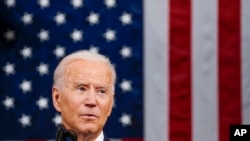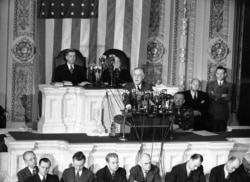More than three months after being sworn in as the 46th president of the United States, President Joe Biden will soon pass a milestone: his first 100 days in office.
On Friday, April 30, administration officials, reporters, the general public and Biden himself will mark the benchmark. But many Americans and people overseas may be wondering what is so special about a president’s first 100 days.
Despite the attention to the day, nothing in U.S. law or the U.S Constitution gives any significance to a president’s first 100 days.
In fact, there is nothing inherently more important about a president’s first 100 days in office than, say, the second 100 days or any other time differentiation of a president’s four-year term, which totals 1,461 days.
However, while the 100-day mark is mostly an arbitrary milestone, it has nevertheless become an important symbolic marker when news organizations, political analysts and academics consider how a new president’s administration is doing. The first 100 days often gives an indication of a president’s management style, priorities and speed in implementing campaign promises.
Why 100 days?
For more than 150 years of American presidential history, no one was particularity interested in a president’s first 100 days. That changed, however, during the presidency of Franklin D. Roosevelt, who was first elected in 1932, during the Great Depression.
Roosevelt set out to make significant and quick changes in economic and social policy, through both legislative and regulatory actions.
On taking office, he summoned the U.S. Congress to a three-month special session and, by the end of his first 100 days, had passed 76 new laws, mostly aimed at easing the effects of the Depression.
Shortly after taking office, Roosevelt also gave the first of many so-called “fireside chats” in which he spoke directly to the American public over the radio and explained in simple terms how he was trying to solve the country’s problems.
In one fireside chat, the president noted how busy and important his first 100 days had been. The term stuck.
A high bar
Since then, U.S. presidents have understood they will be measured by how ambitious and successful their first 100 days in office are.
While the 100-day milestone is mostly arbitrary, the early days of a presidency can be a choice time for new presidents to make big gains in their agenda. A new president is usually still popular with the public, and lawmakers often have incentive to cooperate with a new leader, creating an opportunity for a president to pass major legislation.
While many presidents have pushed through legislation at the beginning of their first term, historians have found that no modern president has done as much in the first 100 days as Franklin D. Roosevelt.
Roosevelt faced the unique circumstances of entering office during the Great Depression, the likes of which other presidents had not encountered.
As a result, many presidents try to lower expectations about what they can do in their first 100 days. As President John F. Kennedy said at his 1961 inauguration ceremony, “All this will not be finished in the first 100 days. Nor will it be finished in the first 1,000 days, nor in the life of this administration, nor even perhaps in our lifetime on this planet. But let us begin.”
One of President Barack Obama’s senior advisers, David Axelrod, called the 100-day benchmark the “journalistic equivalent of a Hallmark holiday” because it attracts a lot of fanfare but has no real significance.
Biden’s report card
Like Roosevelt, Biden also took office during a time of crisis — with the coronavirus pandemic gripping the world — and has sought to quickly act as president.
In his first 100 days, Biden has signed a host of executive orders relating to the pandemic and pushed a $1.9 trillion coronavirus relief bill through Congress.
Biden’s goal of administrating 200 million COVID-19 vaccinations in his first 100 days was met early, allowing the president to double his promised doses.
According to an Associated Press tracker, Biden has fulfilled or started to fulfill all his key campaign promises concerning fighting the coronavirus. Overall, the AP finds Biden has fulfilled 25 out of 61 promises and has started on 33 others.
In terms of the number of laws passed, Biden has signed 11 bills in his first 100 days, according to the website GovTrack, a relatively low number, with only George W. Bush signing fewer in modern history. The presidents who passed the most laws in their first 100 days after Roosevelt were Harry Truman, with 53, Kennedy, with 26, and Bill Clinton, with 22.
Biden has signed the most executive actions, which do not require passage through Congress, after Roosevelt, according to the American Presidency Project at the University of California, Santa Barbara.
The project says Biden has signed more than 100 executive orders, memoranda or proclamations since taking office. Before Biden, former President Trump held the No. 2 spot, with more than 85.
Remaining term
While a president’s first 100 days are an important indication of how a president is faring, they do not always indicate what actions a leader will take later in their term.
In fact, many observers point out that the major issues previous presidents faced often came much later in their terms. For example, George W. Bush had been president for more than 200 days when terrorists attacked the United States on September 11, 2001. President Ronald Reagan was in his second term when he famously called on Soviet leader Mikhail Gorbachev to tear down the Berlin Wall.
Roosevelt was also equally defined by events happening later in his presidential term: In 1941, he led the United States into World War II.










